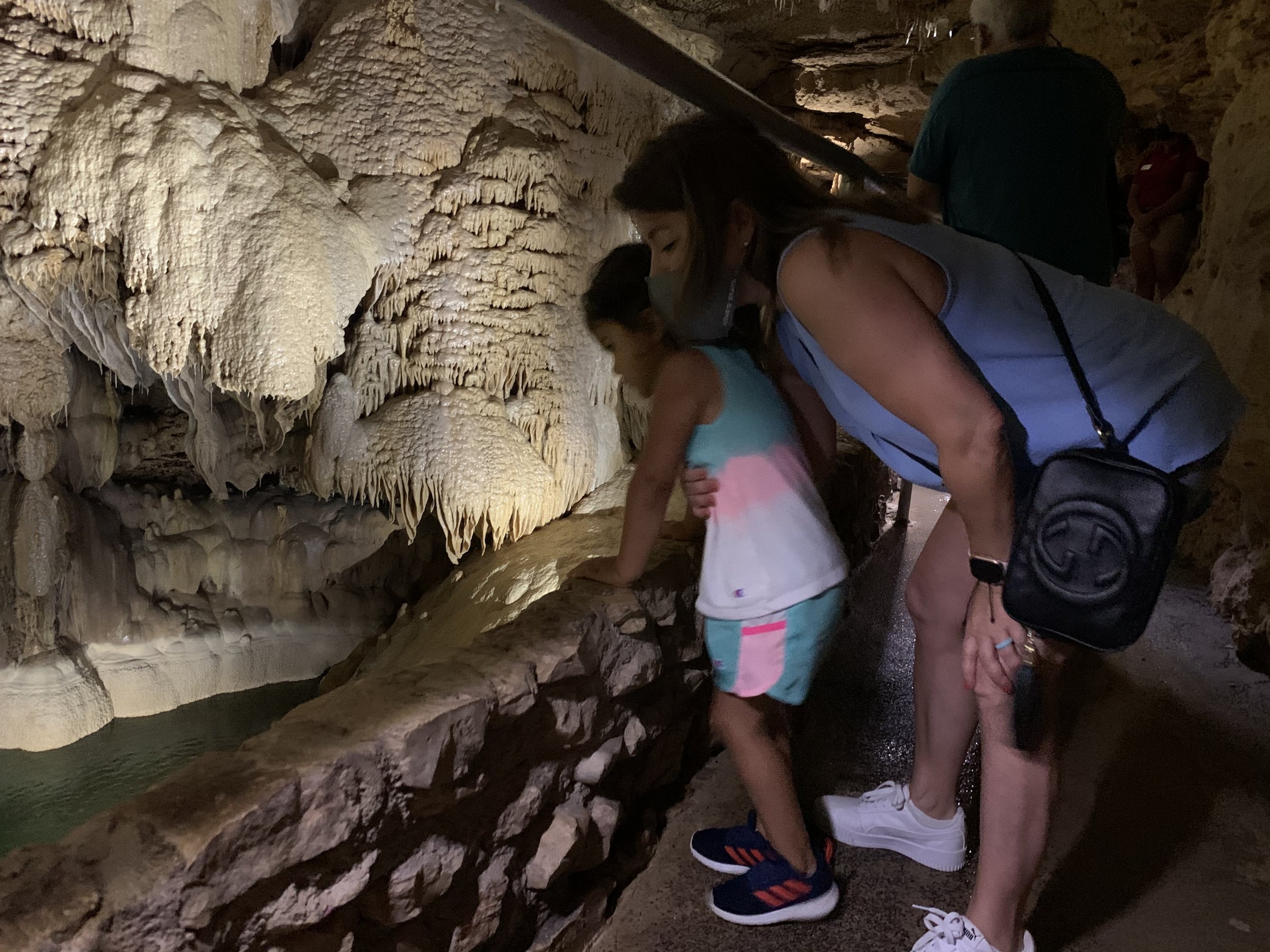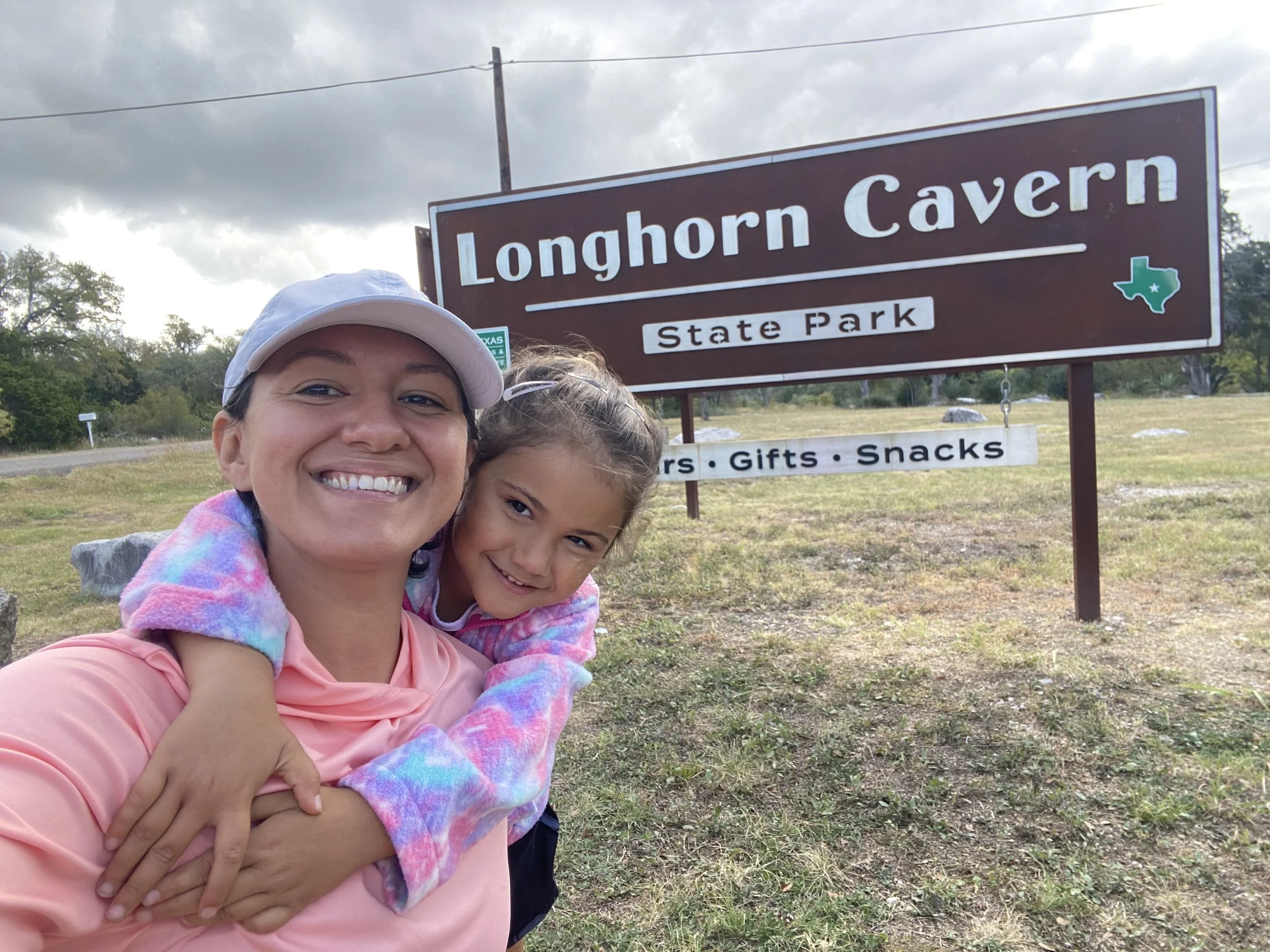How to Travel Texas Beneath its Rolling Hills
Natural Bridge Caverns
Growing up in the Texas coastal region, it was always a treat to visit the Hill Country. It’s not as flat as the coastal prairie, although not much of a prairie exists, and it is very encouraging to be outside. I’ll never forget the few times we visited Natural Bridge Caverns outside San Antonio, sometimes visiting the safari next door. It’s a great way to beat the Texas summer heat with temperatures reaching 70 degrees.
Like most people, I was getting anxious about staying local throughout the pandemic. Thankfully, Texas began to reopen establishments, not without institutional restrictions, so I began my research on places to travel with my daughter. I remember the awe-inspiring underground structures as a kid and I just knew she’d equally look up in true amazement with a sparked imagination. This trip was a few months before I traveled to Carlsbad Caverns where the system is over 30 miles long. Natural Bridge Caverns is just less than a mile in length. My daughter had a great experience and I loved observing her curiosity as she engaged with questions throughout the tour and made it a point to always be in the front.
If you’re in Texas, or looking for places to visit in the Hill Country, I highly recommend adventuring through Texas’s largest commercially operated cave system. Keep in mind that the cavern is not accessible to those with mobility restrictions due to the narrow, steep, and in some areas soaked pathways. However, if your little can stay with the group and keep their hands away from touching everything, you’ll all have a great time.






As we stepped up to purchase our tickets, I looked to my right and saw a “Texas Cave Trail Passport” with guidelines on how to acquire an exclusive tee shirt once completing the Texas cave system. The map had a printed map of the five caves that participate in the passport system. I couldn’t resist; I was ready to start a new adventure I never knew was a possibility. I did some light research on these five caverns only to discover there are thousands of caves and caverns beneath the rolling hills of Texas. Here is where I found yet another reason why I love living in this state!
Not all caves and caverns have public or commercial access.
There are at least 13,000 known caves, sinkholes, and springs beneath the Earth’s surface. The abundant limestone allows for water to carve its way through cracks and pores, creating solution caves, the most common caves throughout Texas.
Inner Space Cavern
Fast forward to the winter months, the weather simmered down and we continued our adventure to Inner Space Caverns in Georgetown, Texas, just an hour north of Austin, Texas. This time my daughter was encouraging me to keep pace with the group as I fell behind to snag some photos of the cavern’s chambers. The tour moved along fairly quickly and I lacked the confidence in my photography skills to practice in such dark spaces. Inner Space Caverns is the fourth largest cave in Texas at a length of five miles and a depth of 69 feet. At an age of 20-25 million years, the cave was discovered by the drilling team of the Texas Department of Transportation in 1963 while developing Interstate Highway 35. Ignorant to the sensitive area, an employee plummeted below the earth. After a successful rescue, archeologists and geologists unveiled evidence of several animal skeletons that once roamed the area during the prehistoric Ice Age, including a baby mammoth, giant sloth, and the saber-toothed tiger. Through several openings, various species found themselves trapped in the cavern never finding a way to escape. The low light and glare on the plexiglass also made it difficult to capture images on my phone, but I did manage to take a short video of the cave art from a UT professor when tours became public in 1966.
Displayed is a giant ground sloth, small horse, sabre-tooth tiger, and more. The cave art was originally painted by former UT professor, Dr. Farry, utilizing real cave art from France.
The tour was quick and easy, but not without learning some fairly interesting facts about its development. Since the original openings were sealed up since the Ice Age, the only way to access the chambers was through dynamite. Aside from walking guided tours, Inner Space Caverns offers various spelunking tours available for those aged 16 and up.
I forgot to bring our cavern passports, so the staff kindly punched another panel for us with the date. Both trips to Natural Bridge and Inner Space Caverns were before my trip to Carlsbad Caverns in New Mexico; however, I did manage to remember to take a few pictures on my phone.
Longhorn Cavern
Another year passed and I felt our next Texas cave trip was overdue. We made plans to extend our trip a little further and camp close by so as to not rush home after a full day of adventure. By this time I had completed my trip across the Chihuahuan Desert and gained more assurance in my landscape photography skills, especially after visiting Carlsbad Caverns National Park—I had also upgraded my camera from a Canon T7 to a Canon 90D.
We headed west for Longhorn Caverns in Burnet, Texas, about an hour west of Austin, Texas. I had always wanted to explore west of Austin, and I was finally getting my chance with my favorite travel partner.
Once again, I forgot our passports. Again, the staff was generous in punching a new panel with the current date. Still not quite paying attention to the tour guide, I looked for opportunities to capture some landscapes. A few times throughout the guided tour, I got the feeling our guide was determined to keep moving and thought I wish there was a way to come out here just to practice.
I felt more confident about my final images, however, I remained awkward using an external flash—especially with the guide ready to keep moving the crow along. Despite my obstacles, I knew I had plenty of room to grow. Longhorn Caverns also offers various guided tours, including a wild tour.
Like most caves in Texas, Longhorn Cavern is located on private property and is managed by the Civilian Conservation Corps, a program created during the Great Depression by Franklin Roosevelt to put young men to work around the country. The CCC still operates today and works diligently to prevent the public from destroying millions of years of the development of the caves through unnecessary contact. The main chamber has what is known as The Queen’s Throne, where many dates were held before conservation efforts. Pictured below is known as the Queen’s Watchdog. Although it looks man-made, the formation is naturally-made dolomite, a more dense form of limestone.
The Queen’s Watchdog. October 2022
Longhorn Caverns is said to have gained its name from grazing cattle falling through the Earth’s opening.
It wasn’t until completing our tour that I dived deeper into the geographical history of the Longhorn Cavern. The Texas cave has been known to provide refuge since its early discovery, predominately taking advantage of the shelter just outside the entrance. Stories of who occupied this space range from Paleo-Indians to Comanche tribes, a speakeasy for locals throughout the 1920s-1930s, and a bomb shelter during the Cold War.
There is an unverified legend that Sam Bass, a Texas outlaw throughout the mid-19th century, stored his loot in the cave.
Further back, there was a major earthquake roughly 20 million years ago. As a result, the Balcones Fault was established which expanded vast cave systems below the Texas hill country. The water seeped through the limestone, cutting and carving. The water continued downward for some time, creating an underground river that has since drained. This space is unique and spectacular. Another easy trek for kids.
Inks Lake
Inks Lake is only a 20-minute drive from Longhorn Cavern, both part of the Texas State Parks. Once we completed the short tour at the cavern, we set up our campsite and hit the Valley Spring Trail. Most of the hill country is full of limestone, aged to tens of millions of years, but this trail is made a unique formation known as Valley Spring Gneiss which dates back over a billion years. I love hiking Texas throughout the spring and fall seasons, making it easy to enjoy the outdoors in the middle of the day. After watching a vibrant sunset, we celebrated our trip with a small campfire. Naturally, we brought ingredients to make s’mores—my daughter’s favorite camping tradition.
I’m glad we extended our adventure outside the cavern. Ahead of leaving Inks Lake the next morning, we snuck in one last hike for a little more exploration of this beautiful landscape and a small play session with neighboring families at the playground.































